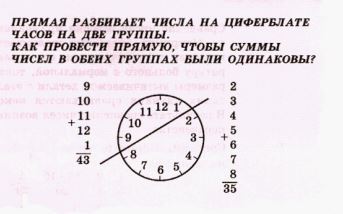Answer the question
In order to leave comments, you need to log in
How to solve this problem without "selection" of values?
Hello!
Forgive me for such a possibly stupid question, but is there a universal approach to solving this problem, for example, for 18s, 54s, etc.? digit dials? without enumeration of values, of course
Answer the question
In order to leave comments, you need to log in
Easily. But for this, you need to look at the dial from different angles.
First, let's look at it as an arithmetic progression. A1 == 1; A12 == 12; D == 1.
Progression sum formula: S = (A1 + An) * n / 2;
We calculate the sum of our series, it is equal to 78. And then everything becomes very simple.
Now let's look at the dial as a dial. It has 12 meanings connected in a ring.
By drawing a line and dividing the dial into two parts, we kind of create two areas of arithmetic progressions.
Moreover, the sum of the sums of these progressions will be equal to the sum that we have already calculated.
Therefore, it is enough for us to find such a section on the dial, the sum of the numbers of which would be equal to exactly 39 - half of the sum already calculated from above. Otherwise, the condition of the task will not be fulfilled.
It turns out that we have not 12, but 6 elements in the desired sequence. D is the same, but A1 and A6 are unknown to us. You can find them through the same sum formula.
39 == (A1 + A6) * 6/2
13 == A1 + A6
A6 == A1 + D*5
13 == 2*A1 + 5
8 == 2*A1
A1 == 4
A6 == 4 + 5 == 9
That's it. The first group is [4..9], the second is [1..3,10..12], the sums of both sequences will be equal to 39, and together - 78.
Why exactly 6 elements... We look.
For a dial set, the sum is:
78 == ( 1 + 12 ) * 12 / 2
For a subset, the following sum should hold:
39 == ( 2A1 + N - 1 ) * N /
2
( 1 + 12 ) * 12 / 4 == ( 2A1 + N - 1 ) *
N
/
2
N/2
Voila!
N == 6; and from the first equality it is very easy to deduce A1, which is equal to 4.
Yevgeny Shatunov
's entry was correct, but here are the justifications that there are no 6 of them. And this is the most interesting!
As shown above, we should have a sum of 39.
Consider a series that does not go through 12, i.e. is an arithmetic progression. Let's return to its sum again and present it in general form:
S = k*n ,
where k and n are integers. In this case, there are two options: k is the sum of the first and last element, and 2n is the number of numbers in the sequence, or vice versa. In the general case, the number of possible solutions determines the number of combinations of factors of the final sum S.
In our case, 39 has only one decomposition (39 = 13 * 3) 13 elements we cannot have according to the condition of the problem, which means this is the sum, and therefore the number of elements n = 2*3=6.
Somehow I came across a similar problem that had a successful solution with a line dividing the number 12 by 1 and 2 ;)
And so - the simplest solution is by enumeration. Since the search is not large: we calculate the sum, find half, assume that one of the ends of the line is between 12 and 1, check if the second end can be placed somewhere, then move the first between 1 and 2, check the second again, etc. . Even for very large clock faces, a computer will solve such a problem in milliseconds.
If you want intelligence, please: on the first pass, we find the only solution or the two nearest unsuitable options. On the second, it turns out that we subtract from the sum the number on which the sequence began, but add 1 for each member of this sequence. We compare the result with those numbers that the second end rests on ... in general, I suspect that the calculation will be longer than the primitive proposed above.
but there is a general way, for dials with an even number of numbers - the solution is simple - we take the middle between 1 and N (12 for simple watches) and the center of the dial, draw a line, and build a perpendicular to this line through the center. all. solution is ready.
sum 6+7 (6.5-0.5 + 6.5+0.5 ) + 5+8 (6.5-1.5 + 6.5+1.5) + 4+9 ( 6.5 -2.5 + 6.5+ 2.5) =
3+10 (6.5-3.5 + 6.5+3.5) +2+11(6.5-4.5+6.5 +4.5) + 1+12(6.5-5.5+6.5+5.5).
the solution applies to any clock face with an even number of numbers.
If there are an odd number of numbers on the dial, then we build a straight line through the maximum (13 directly) and we build a perpendicular to it through the center. the proof is similar in structure.
Didn't find what you were looking for?
Ask your questionAsk a Question
731 491 924 answers to any question